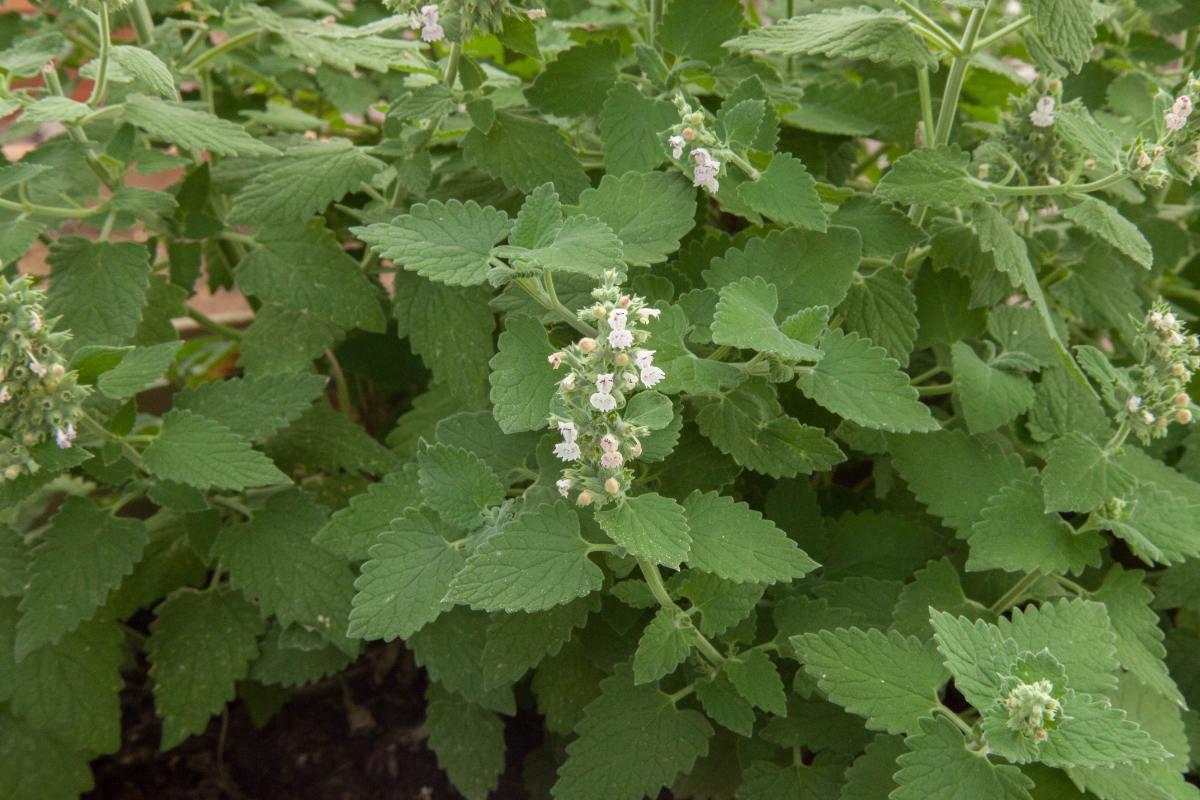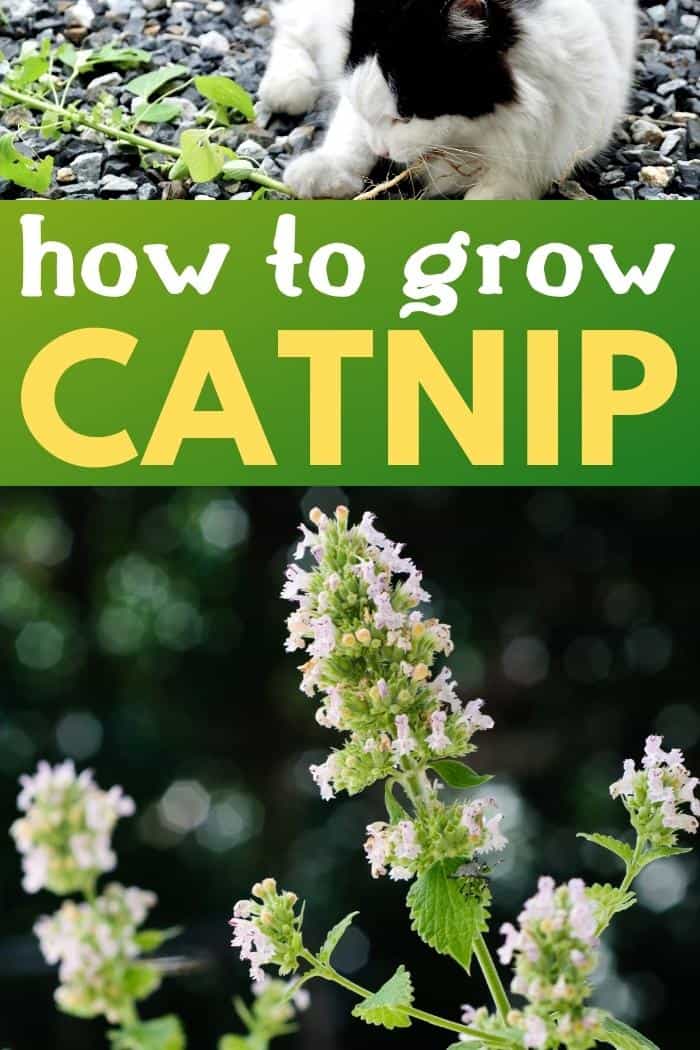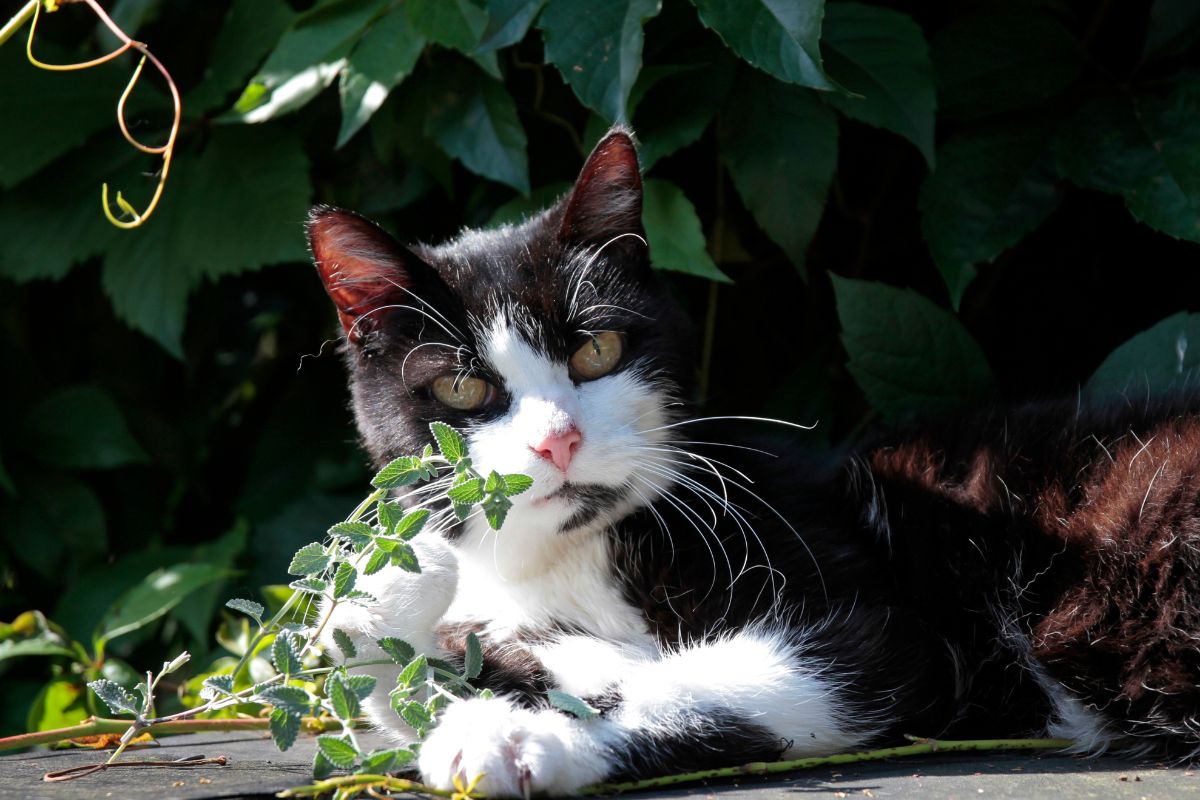Catnip (Nepeta cataria) is an easy to grow, perennial herb that is part of the mint family. Catnip is native to Europe and Asia but is now widely grown across North America.
It can be grown as a perennial in Hardiness Zones 3-9, in cooler climates it can be a self-seeding annual.
This site contains affiliate links. If you make a purchase using one of these links, I may earn a commission. Please see my disclosure page for more information about cookies collected and our privacy policy.
The catnip plant has green, toothed edged leaves and flower spikes with white flowers that bloom in the late spring and continue until early fall. It can be somewhat weedy in appearance and can spread quite readily.
Catnip is most widely known as a stimulant for cats, but there are lots of other uses and benefits for growing catnip!
Many use the names catnip and catmint interchangeably, but they are actually different plants. They are both members of the mint family and are very similar but have differences in appearance, growth habits, and catmint won’t stimulate cats like catnip does!
Why You Should Grow Catnip
The most common use for catnip is, as the name implies, for cats. Catnip is a stimulant for cats when it’s sniffed, but can have a calming effect when it is eaten. So how can you use catnip for your cats? Here are just a few ideas:
- Create your own cat toys by filling old socks or cloth bags with the dried leaves
- Place around a cat bed or scratching post to encourage use
- Add some inside a carrier if you have to take your cat to the vet or in the car
In addition to being used for cats, catnip can is also good for:
- Attracting pollinators to your garden. They just love the flowers!
- Attracting beneficial insects such as lacewings to your garden.
- Drying and brewing tea. It has a nice calming effect similar to chamomile that can help with sleep or headaches.
So now that you know WHY you should grow catnip, let’s talk about how to grow it!
How to Grow Catnip from Seed for Your Garden
Before we get to how to grow catnip, let me mention that catnip, like many plants in the mint family, will spread once established in your garden. They can grow 3-4 ft in height. I’d also like the mention that catnip is also considered invasive in some areas.
If you want to control the catnip, then growing in containers can be a great option.
Catnip is super easy to grow from seed. Seeds are easy to find, inexpensive, and germinate very readily, making it the perfect herb for gardeners of any skill level.
Catnip can be started inside 6-8 weeks before your last frost date. It can also be directly sowed in the ground after all chance of frost has passed.
Starting Catnip Seeds Inside
- To start catnip seeds indoors you’ll need the following:
- Quality catnip seeds
- Seed trays
- Seed starting mix or peat pellets
- A grow lights- or a sunny window sill
To plant the seeds, simply sprinkle the seeds on top of the soil and press in gently with your fingers. You can top with a very light sprinkling of soil.
Place the seeds in a sunny location and water often. I prefer using a pump spray bottle to keep the soil moist, but not too wet. Don’t let the soil dry out, or your seeds may not germinate.
You should see sprouts within 7-10 days.
Continue to water daily as the seedlings grow. They can be planted out after all danger of frost has passed- but don’t forget to harden them off first!
Be sure to keep your cats away from your catnip seedlings so they don’t destroy them before they can withstand the damage!
Don’t want to deal with starting seeds indoors? Catnip can also be directly seeded into the garden. Just sprinkle the seeds into your prepared spot and cover with a very light sprinkle of soil. Water daily until you see sprouts.
Depending on how fast your catnip seedlings grow, you might have to transplant them into larger pots before they can be planted out in the garden. And as the weather warms, begin hardening them off outside for a few hours each day to get them used to the elements.
Growing and Caring for Catnip Plants
Once your catnip is big enough and the weather has warmed up, it’s time to plant your catnip outside. Catnip does well both in the ground and being grown in containers. You should space your plants 18-24 inches apart to give them ample room to grow without being over-crowded.
Catnip prefers to be grown in full sun, though it can also thrive in partial shade- especially if you live in a hot climate.
Catnip can spread, so planting in a large pot or in a raised bed can help contain it and keep it from becoming invasive to your garden.
Catnip isn’t picky and grows readily in many different soil conditions. They can even thrive in very poor soil! Make sure that your prepared area has good drainage to keep your plants and roots healthy. You can dig in some compost or well-rotted manure before planting to give your catnip plants a good start.
Catnip is drought resistant, so unless you have extreme dry periods without rain, you shouldn’t have to water your plants.
Catnip is virtually pest free, but it can sometimes be bothered by the following pests:
- Aphids
- Spider mites
- Whiteflies
- Flea beetles
If you notice issues with pests, try a little diatomaceous earth or neem oil to help control them.
Pruning Catnip
Catnip doesn’t have to be pruned, but it will help keep the plant from getting out of hand. And it can help produce a bushier plant with lots of stems and leaves.
You can regularly pinch off the upper stems, just above a set of leaves. This will give your plant a bushier appearance.
You can also cut off any flower heads that start to grow on your plant. Preventing flowering for as long as possible will keep your plants from getting scraggly.
Once your plants flower, cut off old blooms. This will encourage more growth and prevent seed heads from forming and self seeding around your garden.
Harvesting Catnip
You can harvest catnip leaves any time after your plant has reached about 6 inches in height. You can use the leaves and stems you snip off at pruning time just like you would any other catnip.
The essential oils in catnip are at the highest right around the time your plants bloom, so this is the best time to harvest a lot of catnip. Catnip is very resilient, so you can harvest over half the plant and it will continue to grow and give you multiple harvests per season.
It’s best to harvest catnip in the late morning before the sun is too hot, but after the morning dew has dried.
How to Dry and Use Catnip
Drying catnip is very simple. You can dry it one of 3 ways:
- Hang up bunches and air dry
- Use an electric dehydrator (95-105 degrees)
- Use a solar dehydrator
Dry the leaves and stems until they are very dry and crunchy. They should crumble into dust when ground. Store the dried leaves in a glass jar with a tight lid for up to a year.
What can you do with catnip? Here are a few ideas:
- Make cat toys! A simple toy is to fill an old sock with dried catnip and tie the open end in a knot. If you can sew you can make fancier toys stuffed with catnip!
- Rub dry catnip on your cat’s bed, scratching posts, or in their carrier to help calm them or encourage them to use the area.
- Make a soothing and relaxing tea for you to drink!
Catnip is a wonderful, fragrant herb that is fun to grow- both for you and your cats! It’s one of the easiest herbs to grow and it doesn’t have many pests or diseases, making it perfect for beginners!
More Herbs to Grow:
How to Grow Basil
How to Grow Rosemary
How to Grow Calendula





